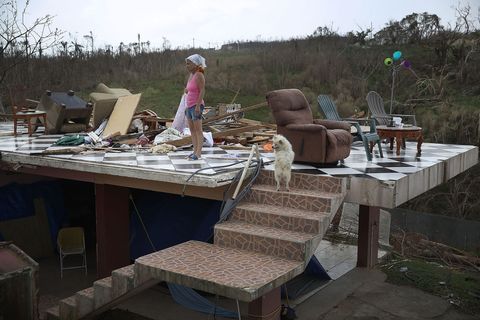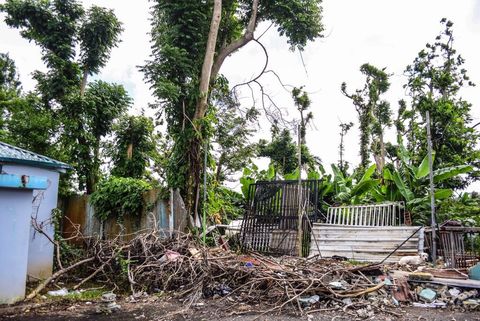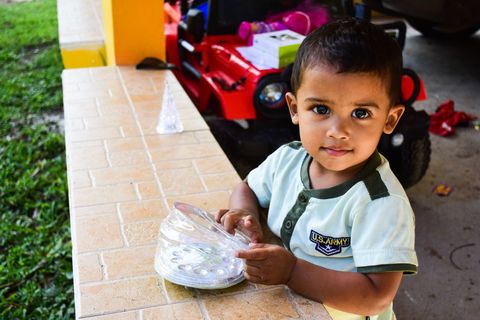This week marks three months since Hurricane Maria made landfall in Puerto Rico, unleashing the full force of a Category 4 storm on the American territory. The intensity of the 155 mile-per-hour winds and the ferocity of the rainfall led the island's residents to believe they had encountered something not of this world. One woman standing in a foot of water in her bedroom nearly a month later told a CNN reporter that "when that roof came off, what came in here was the Devil."
The troubles were never going to recede with the storm. The recovery was always going to be long, hard, and frustrating. But reports on the ground in the ensuing weeks quickly made it clear that the federal government's effort was unacceptably slow and perilously inept. One month after the storm, one million Puerto Ricans—American citizens—were without water. Three million were without power. Two weeks after the storm, international relief organization Oxfam elected to intervene for the first time on American soil since Hurricane Katrina. They did so for the same reasons as in 2004: the U.S. government's response was insufficient, and people were suffering—and likely dying—as a result.
Eventually, the federal government's response picked up (notwithstanding the visit of President Trump, widely characterized as a "political disaster" that culminated with him shooting paper towels into a crowd of hurricane victims). FEMA picked up some slack, and so did a massive deployment of military and federal personnel. Still, even now, Puerto Rico is in serious trouble. More than 200,000 residents have fled for the mainland United States, but those that remain are widely without the resources they need. The military and its helicopters are gone now, but Oxfam remains. So does FEMA. And they all have a lot more to do.
We spoke by phone with Oxfam America President Abby Maxman, on the ground in Puerto Rico this week to take stock of things, as she drove the winding roads down from the island's highland areas back to San Juan. We also spoke with Daniel Llargues, FEMA's national media lead stationed in San Juan. Here's what they had to say about the state of affairs in this American territory three months after Maria.
Authorities are still struggling to restore power.
According to The New York Times, the power grid on the island is still only operating at 70 percent of its capacity before the storm. The preexisting weakness of the grid has been widely reported, but it's a problem that has wreaked havoc across the island over the last three months—particularly the more rural areas.
"In the two municipalities where we were today, it was really only very center of town buildings had power," Maxman says. "In Comerio [a rural municipality] the power for the center of town only came on Sunday of this past week. The whole community was living without power."
Llargues directed me to status.pr, a website for tracking FEMA's recovery efforts, for statistics on power restoration. That seemed to indicate that "AEE"—the Spanish name for the Puerto Rican Electric Power Authority—was generating at 65.4 percent capacity.
Access to clean water is still a major problem.
Finding clean water was once so difficult that Puerto Rico's residents turned to water at toxic waste sites. Now, status.pr indicates the Puerto Rico Aqueducts and Sewers Authority is operating at 86 percent capacity, but it's unclear whether all of that is potable and accessible to citizens.
"Water is the most serious issue, and continues to be," Maxman says. "Some of Oxfam's work includes providing water shelters and training to help people keep their water clean while the water systems are not yet functioning." That's linked to the failure of the electric grid, "but also the water is contaminated. Even if someone's able to get the whole system working, there's a need to do water testing. It's critical to people's health and daily lives." She related the story of one woman whom her Oxfam team had given water filters some weeks ago, when she was experiencing lots of intestinal issues and very unwell.
Access to food and functioning hospitals has improved.
"100 percent of hospitals are back open, treating patients," Llargues said. "Dialysis centers are opening as well." Status.pr echoed that, and also lists 92 percent of supermarkets—and 84 percent of gas stations—as open. "There are some food distributions provided through the local authorities, and shops are now open," Maxman adds. "There's issues of cost affordability, but people are able to go to the stores and purchase [food]."
Cell service is returning.
Mobile phone service "has been spotty, but I'm told it's vastly improved over several months ago—and even several weeks ago," Maxman says. "So there is progress." Status.pr indicates 91 percent of telecomms service has been restored, along with 86 percent of "cell sites."
Paperwork remains a significant obstacle.
Getting disaster relief involves filing a lot of paperwork. That can be an obstacle for many people, who might not be familiar with the process—or their rights. "We're providing support to families in terms of their FEMA forms and applications and appeal processes," Maxman says. "Now [the effort] is with local FEMA authorities as well. But groups of lawyers and notary services are providing support in the municipality of Comerio for just 80 families today.
"There's the issue of land rights, and their ability to access the basic forms and services," Maxman continues. "Some have submitted their applications and been rejected. We're not getting anything close to the compensation that is required to rebuild. It's important to build back strong and build back better—that's critical right now. By underinvesting in that, it perpetuates a week system and a weak cycle. People have a voice now and understand what their rights are and have support to make the claims of what they're entitled to."
She added: "There has been underinvestment in disaster preparedness, planning, and basic infrastructure and support services. There's an expectation in the world's wealthiest country that those basic services should be in place."
The recovery has been significantly slower and less effective in remote and highland areas—but parts of San Juan, too.
"At one point, we had 78 choppers from DHS and DOD and other agencies doing air commodity drops," Llargues said, "bringing in food and water to the communities that otherwise couldn't go through roads or through a convoy." But by Maxman's account, that hasn't been enough. The roads are mostly cleared now, but more help hasn't followed as quickly as expected.
"I think it's important to note that it's not only in the Highland municipalities where services are just coming back," Maxman says. "It's also in San Juan itself. It's really quite shocking how long and slow it has been, and what it's taking to get back and move the recovery forward." That's where the comparisons come in: "By any standard, three months where a majority of the population don't have access to clean water or electricity is a sign that it's been an exceptionally slow and really unacceptable level of response. And I think that it is exposing issues that remind us of things from Katrina as well."
Llargues, though, maintained the challenge was always extraordinary: "Puerto Rico suffered two major hurricanes in this one season. You know not only Maria, but Irma came by. The recovery process is going to be long. Puerto Rico hasn’t seen a storm such as this one since 1928. This is an island that's a thousand miles from the mainland. It's not Texas, where you can preposition commodities [supplies] at five or six different points. There were 350 to 400 [federal] employees here before Maria hit, and the distribution center in San Juan was stocked up. We started moving commodities immediately, but you also have to make assessments: Which roads can we go to? Are the ports open? Is the airport open? So to say that it was slow or inadequate—I think it is inaccurate."
The problems have roots well before the storm, and will take a long time to remedy.
"We still have a long road ahead of us," Llargues says. "We're going to be here for a long long time to support the government of Puerto Rico." The problems restoring power are rooted in an already weak power grid, which Maxman boils down to preexisting social inequities. "There are underlying issues of poverty and inequality here that have been hidden," she said, "and what Maria did is really expose that I think to the country and to the world as well." Puerto Rico's economy has been in dire straits for some time, as has the island's budget. That likely won't be helped by the tax reform bill that passed Congress this week, and will almost certainly go into law with President Trump's signature. The bill's reorganizing of Puerto Rico's tax status will see a 12.5 percent tax imposed on intellectual property in the territory, which could see the manufacturers who make up a huge share of Puerto Rico's GDP flee the island.
Maxman sees Oxfam's role as more than supplying water filters. It and organizations like it are charged with bringing—and maintaining—awareness of the problems on the ground. "There's a risk at this point when you're three months after a disaster of the media cycle ends, interest ends and it becomes an abandoned recovery if you will," she said. FEMA is receptive to the role of Oxfam and other NGOs. "The more nonprofits and organizations that come together to help, the better," Llargues says. "Working with the Red Cross, working with Salvation Army—this is a whole community approach and that's well what about how we approach disasters and preparedness to make sure that everybody is involved."






